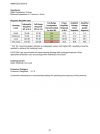JSmith
Master Contributor
The input socket is like one of these connectors from what I can see... XLR/TRS;If that's the case then using the combination input connector was a serious mistake.

JSmith
The input socket is like one of these connectors from what I can see... XLR/TRS;If that's the case then using the combination input connector was a serious mistake.

The input socket is like one of these connectors from what I can see... XLR/TRS;

JSmith
You mean this part I gather...A little reading might help
This, of course, has the down side that you've got to be very careful what you're plugging in where. Plugging a TS cable into a TRS output could damage your equipment.
If there really is an internal rail-splitter in linear class-A/B we'd still have some useless power dissipation, being just an undriven bridge half. Large local bulk caps after the splitter do help... but not much for very low frequencies. The amp isn't DC coupled but what happens with, say, a <20Hz "earthquake" mono signal at full blast?
If split locally, why then the 3-prong DC supply connectors? This style is available in 2-, 3- and 4-pin variants. Maybe the 3-pin was simply the cheapest they could get?
What is the reason for forcibly connecting an unbalanced signal to an amplifier dedicated to balanced input?Porbably. At least that's what Topping states: "compatible with XLR and TRS interfaces", not explicitely mentioning TS here.
OTOH, a balanced input by sheer definition must handle unbalanced signal as well with no problems, otherwise it's just not a viable balanced input whose definition is to subtract out any common-mode signel (when driven with TS unbalanced cable then the common-mode signal is simply half of the differential signal).
Offering TRS input invites users to plug in TS inputs (or RCA to TS adapters) and therefore it would be very strange if TS really isn't allowed (aka creating problems). Or did they state that just because the leakage current from their PSU is very high which easily creates noise in unbalanced interconnects?
This is Topping and as we have seen for the PA5 Inpus they may do things in a non-conformant style and provide little technical detail about connection / input topology and its limiting values.
Are any amps configured as a current source? Audio amps are (to my knowledge) always voltage sources.
You mean this part I gather...
Okay... so you're about half way through updating your system ... you have your LA90 ... but still have an unbalanced DAC ... There's no reason you can't use it, if those inputs are correctly configured.What is the reason for forcibly connecting an unbalanced signal to an amplifier dedicated to balanced input?
If you just want to make a sound, you can use it like that. But I don't think LA90 is needed for such applications.
For the ANSI/CTA-2034-A standard, the required power is calculated in a roundabout way, and not from the speaker sensitivity. Below is the example report presented in the ANSI/CTA-2034-A document. I'd guess/assume the graphs and numbers come from the same example speaker instead of just some random numbers, but I can certainly be wrong.Apologies in advance if I missed it but what was the sensitivity of the speakers used for this table?


What you were actually referring to may have assisted the conversation. Text only discussions are prone to misunderstandings.A little reading might help
What you were actually referring to may have assisted the conversation. Text only discussions are prone to misunderstandings.

But he measured against the third pin too, of course!It depends which 2 of the 3 pins across are measured. Pick the +/-32 and you get 64.
They use a preamp, or they don't.High gain is 20dB. How do people who want to use it with RCA drive it to full power?
No need to be condescending, it's just a friendly discussion mate. Feel free to PM me if you wish to discuss the matter further.Go back and actually READ at the page this time ...
While it's true for many low level sources, may you explain tour reasoning?They use a preamp, or they don't.
Well, as I said, the whole idea of a balanced input is cancelling principle, that is to look only at the difference signal between pins. You're not forcing anything when, say, one pin is at ground like it is the case here.What is the reason for forcibly connecting an unbalanced signal to an amplifier dedicated to balanced input?
